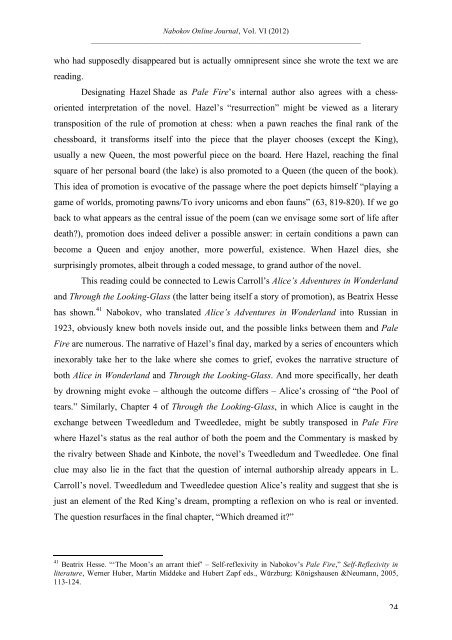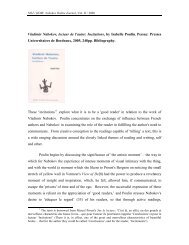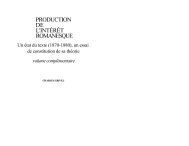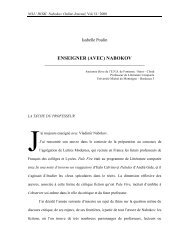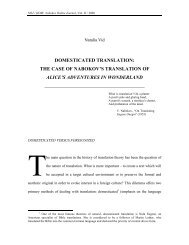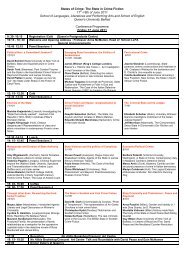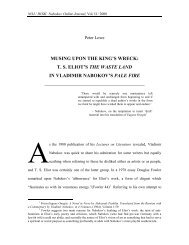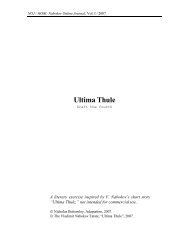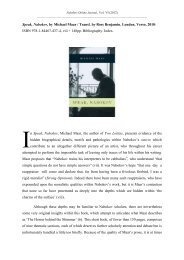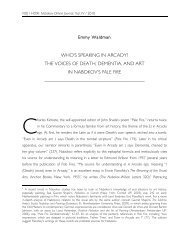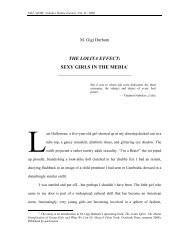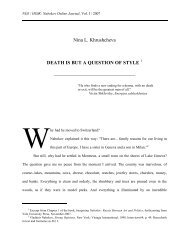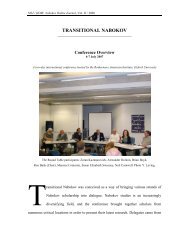through the looking-glass – pale fire as anamorphosis
through the looking-glass – pale fire as anamorphosis
through the looking-glass – pale fire as anamorphosis
Create successful ePaper yourself
Turn your PDF publications into a flip-book with our unique Google optimized e-Paper software.
Nabokov Online Journal, Vol. VI (2012)<br />
_______________________________________________________________________<br />
who had supposedly disappeared but is actually omnipresent since she wrote <strong>the</strong> text we are<br />
reading.<br />
Designating Hazel Shade <strong>as</strong> Pale Fire’s internal author also agrees with a chess-<br />
oriented interpretation of <strong>the</strong> novel. Hazel’s “resurrection” might be viewed <strong>as</strong> a literary<br />
transposition of <strong>the</strong> rule of promotion at chess: when a pawn reaches <strong>the</strong> final rank of <strong>the</strong><br />
chessboard, it transforms itself into <strong>the</strong> piece that <strong>the</strong> player chooses (except <strong>the</strong> King),<br />
usually a new Queen, <strong>the</strong> most powerful piece on <strong>the</strong> board. Here Hazel, reaching <strong>the</strong> final<br />
square of her personal board (<strong>the</strong> lake) is also promoted to a Queen (<strong>the</strong> queen of <strong>the</strong> book).<br />
This idea of promotion is evocative of <strong>the</strong> p<strong>as</strong>sage where <strong>the</strong> poet depicts himself “playing a<br />
game of worlds, promoting pawns/To ivory unicorns and ebon fauns” (63, 819-820). If we go<br />
back to what appears <strong>as</strong> <strong>the</strong> central issue of <strong>the</strong> poem (can we envisage some sort of life after<br />
death?), promotion does indeed deliver a possible answer: in certain conditions a pawn can<br />
become a Queen and enjoy ano<strong>the</strong>r, more powerful, existence. When Hazel dies, she<br />
surprisingly promotes, albeit <strong>through</strong> a coded message, to grand author of <strong>the</strong> novel.<br />
This reading could be connected to Lewis Carroll’s Alice’s Adventures in Wonderland<br />
and Through <strong>the</strong> Looking-Gl<strong>as</strong>s (<strong>the</strong> latter being itself a story of promotion), <strong>as</strong> Beatrix Hesse<br />
h<strong>as</strong> shown. 41 Nabokov, who translated Alice’s Adventures in Wonderland into Russian in<br />
1923, obviously knew both novels inside out, and <strong>the</strong> possible links between <strong>the</strong>m and Pale<br />
Fire are numerous. The narrative of Hazel’s final day, marked by a series of encounters which<br />
inexorably take her to <strong>the</strong> lake where she comes to grief, evokes <strong>the</strong> narrative structure of<br />
both Alice in Wonderland and Through <strong>the</strong> Looking-Gl<strong>as</strong>s. And more specifically, her death<br />
by drowning might evoke <strong>–</strong> although <strong>the</strong> outcome differs <strong>–</strong> Alice’s crossing of “<strong>the</strong> Pool of<br />
tears.” Similarly, Chapter 4 of Through <strong>the</strong> Looking-Gl<strong>as</strong>s, in which Alice is caught in <strong>the</strong><br />
exchange between Tweedledum and Tweedledee, might be subtly transposed in Pale Fire<br />
where Hazel’s status <strong>as</strong> <strong>the</strong> real author of both <strong>the</strong> poem and <strong>the</strong> Commentary is m<strong>as</strong>ked by<br />
<strong>the</strong> rivalry between Shade and Kinbote, <strong>the</strong> novel’s Tweedledum and Tweedledee. One final<br />
clue may also lie in <strong>the</strong> fact that <strong>the</strong> question of internal authorship already appears in L.<br />
Carroll’s novel. Tweedledum and Tweedledee question Alice’s reality and suggest that she is<br />
just an element of <strong>the</strong> Red King’s dream, prompting a reflexion on who is real or invented.<br />
The question resurfaces in <strong>the</strong> final chapter, “Which dreamed it?”<br />
41 Beatrix Hesse. “‘The Moon’s an arrant thief’ <strong>–</strong> Self-reflexivity in Nabokov’s Pale Fire,” Self-Reflexivity in<br />
literature, Werner Huber, Martin Middeke and Hubert Zapf eds., Würzburg: Königshausen &Neumann, 2005,<br />
113-124.<br />
24


